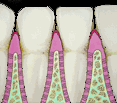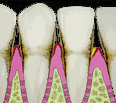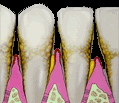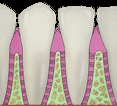The connection between gum disease and heart disease, as well as the connection between gum disease and strokes, has recently been brought to our attention. We have always advocated disease free mouths and now it appears even more important for overall health. Our goal for our own mouths, as well as our patients’, is no bleeding upon probing. Probing is the gentle placement of a tiny ruler under the gums to measure the depth of pocketing. Healthy gums have pockets, which measure 2-3 mm. Unhealthy gums usually have pockets, which measure deeper than 3 mm and frequently bleed. Bleeding is a very potent indicator of disease. Bleeding when probed is analogous to your head bleeding when you brush your hair. In the past, we have accepted bleeding gums as the norm. However, we now know with proper treatment and co-therapy we can help every patient strive for a disease free mouth, Perfect Tissue.


Gingivitis
An estimated 80-85% of the adult population exhibits various stages of gum disease. It is the leading cause of tooth loss in adults. We feel it is our responsibility to thoroughly diagnose gum disease and inform our patients of the different options available to treat the disease. In the past, the dental profession has been somewhat complacent about treating early disease. We tended to “watch it” progress slowly until surgical intervention was required. Research in the last 10 years has shown us that when we intervene in the early stages of the disease we can reduce and/or eliminate the need for gum surgery. Our office has established standardized criteria to evaluate each and every patient for signs of gum disease. We can detect gum disease in the early stages and through a conservative, non-surgical approach help patients control gum disease.


Periodontitis
Signs of gum disease:
- Gums which bleed when brushed and/or flossed (Healthy gums DO NOT bleed)
- Bad breath or a constant bad taste in your mouth (Diseased gum tissues release volatile sulfur compounds which contribute greatly to halitosis)
- Swollen, red or puffy gums (Healthy gums are firm, pink and adhere tightly to the teeth and bones)
- Tartar build-up on your teeth (If you can see or feel tartar above the gumline, there is even more of it you cannot see under the gumline)
- Receding gums (While a small amount of recession can be tolerated, large amounts mean something is not healthy)
- People who do not floss regularly will have evidence of gum disease (Toothbrushing alone will not control gum disease because it does not completely clean deep in between the teeth. This is generally where gum disease progresses rapidly.)
- A history of gum disease in your family (New evidence indicates heredity may play a role in your susceptibility to gum disease.)
- A history of Diabetes in your family or a diagnosis of Diabetes (Diabetics heal poorly and are much more susceptible to gum disease)


Advanced Periodontitis
Our examination of your gums (called a Periodontal Exam) involves visual inspection with magnification, probing (measuring pocket depths) and charting of pockets, and x-rays. We first visually inspect your mouth for swollen gums, tartar on your teeth, signs of receding gums and changes in the color of your gums. We then begin to probe (measure) and chart your pocket depths. We make six individual depth readings around each tooth. This tells us how deep your gum pockets are. We also look for signs of bleeding and pus with each depth probe. Healthy gums have depth readings of 2-3 mm and show no signs of infection (bleeding or pus). Bleeding upon probing indicates infection in gum tissue. Remember that healthy gums do not bleed. Pockets which have a depth of 4 mm or greater indicate unhealthy conditions. The main problem with deeper pockets is the inability to clean past 3 mm with brushing and flossing. The final step in the Periodontal Exam involves x-rays. These x-rays allow us to identify bone loss and changes associated with chronic gum disease. It is important to follow bone loss over long periods of time and yearly comparisons allow us to determine long-term bone changes.
Along with our Periodontal Examination we also look for contributing factors which can lead to increased incidence of gum disease. Things such as smoking, diabetes, certain medications such as Dilantin and Coumadin or a history of gum disease in your immediate family can all contribute to gum problems.


Healthy Gingiva
Our hygiene department is committed to a concept termed, Perfect Tissue. It is our belief thatPerfect Tissue means no signs of infection or disease in patients’ gums. It is really quite simple and we feel it is imperative to overall health.
Leave a Reply
Want to join the discussion?Feel free to contribute!